Okinawan cuisine is unique and different from what you might find in the rest of Japan. It’s shaped by Okinawa’s subtropical climate and a mix of influences from China, Southeast Asia, and America, due to its history as a trading hub and the American military presence.
Instead of rice or noodles, which are common in mainland Japan, Okinawans often eat sweet potatoes and taro root. These became staples because they grow well in Okinawa’s climate and have been important for the diet for centuries.
During our Okinawa itinerary, we came to realise that meat and seafood aren’t as common in traditional Okinawan dishes as you might expect for an island cuisine. This is partly because, in the past, it was difficult to keep fish fresh in the warm climate. So, Okinawans developed dishes that rely more on vegetables, seaweeds like kombu, and tofu. They make a lot of salads, soups, and even tempura with these ingredients.
Okinawan food also includes some unique items like goya (bitter melon), umibudo (sea grapes), and dishes made with SPAM, showing the American influence. The cuisine is known for being healthy, with plenty of antioxidants and less processed food, which some people think is one reason why Okinawans live such long lives. Here are the top Okinawan foods you ought to try when visiting the islands.
Table of Contents
- Okinawa Soba
- Gōyā Champuru (Bitter Melon Stir Fry)
- Beni Imo
- Jūshī (Rice Dish)
- Rafute (Shoyu Pork)
- Taco Rice
- Minudaru (Steamed Pork Loin)
- Soki Soba (Pork Ribs Soba)
- Mimigā (Pig’s Ear)
- Umi-budō (Sea Grapes)
- Hirayachi
- Tofuyo
- Sukugarasu
- Yushi Dofu
- Abura Miso
- Chinsuko (Okinawan Cookie)
- Fuchagi
- Jīmami Dōfu (Peanut tofu)
- Sata Andagi
- Muchi
- Okinawan Brown Sugar
- Chinbin
- Okinawa Ice Cream
- Shikuwasa Juice
- Pineapple Wine
- Orion Beer
- Awamori
Okinawa Soba
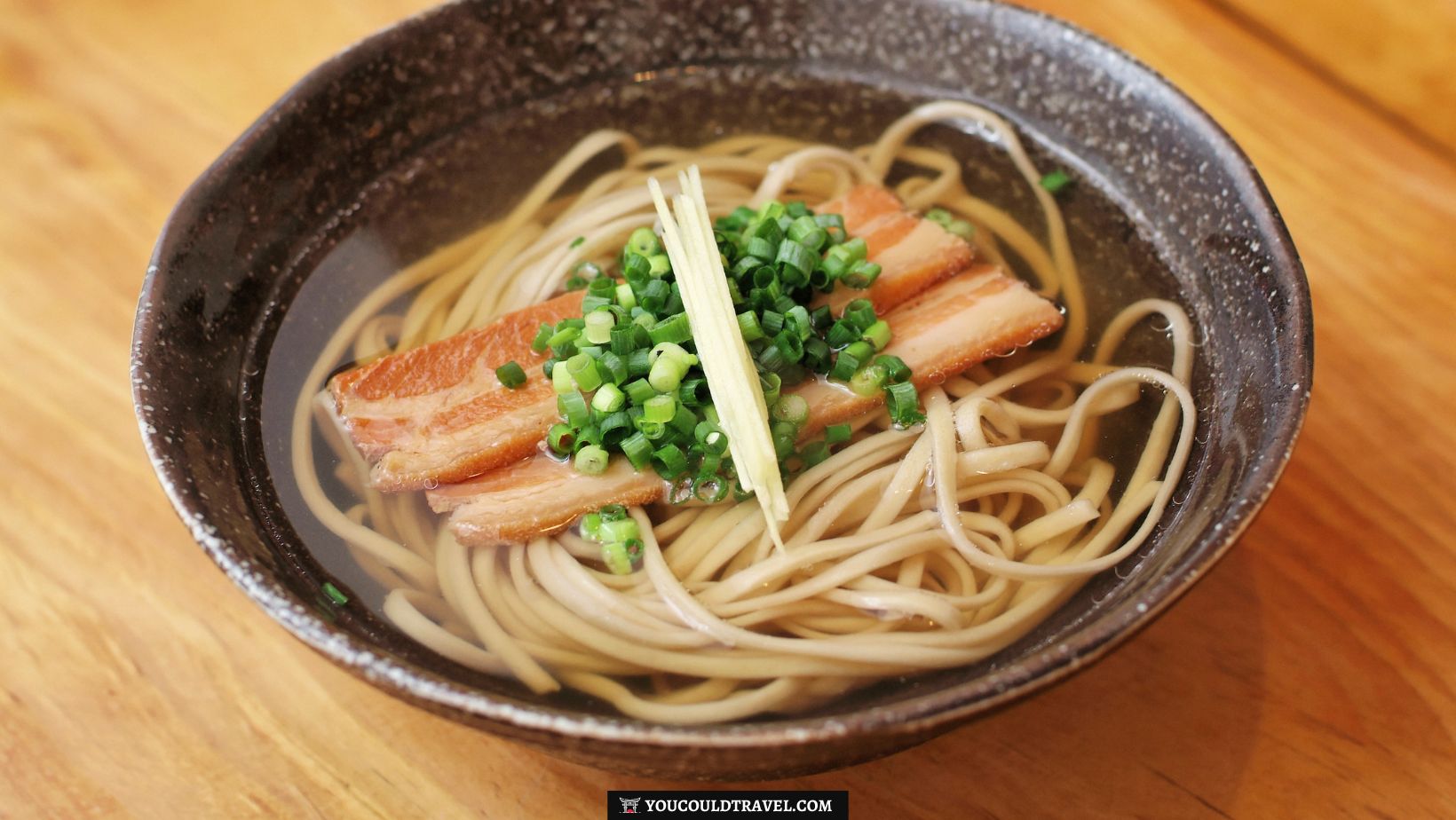
Okinawa Soba is a staple noodle dish from Okinawa made from wheat flour (yes, really!), resulting in a thicker, chewier texture reminiscent of udon but slightly thinner. These noodles are served in a clear broth made from pork or chicken, seasoned with bonito flakes and konbu (kelp), for that rich umami depth we all love.
A traditional bowl of Okinawa Soba is garnished with slices of tender braised pork, known as soki, kamaboko (fish cake), green onions, and a marinated soft-boiled egg. The pork used is often stewed in a sweet and savoury sauce, making it melt-in-your-mouth tender.
Okinawa Soba is a cultural symbol in the region, celebrated annually on October 17th, which is designated as Okinawa Soba Day.
Gōyā Champuru (Bitter Melon Stir Fry)
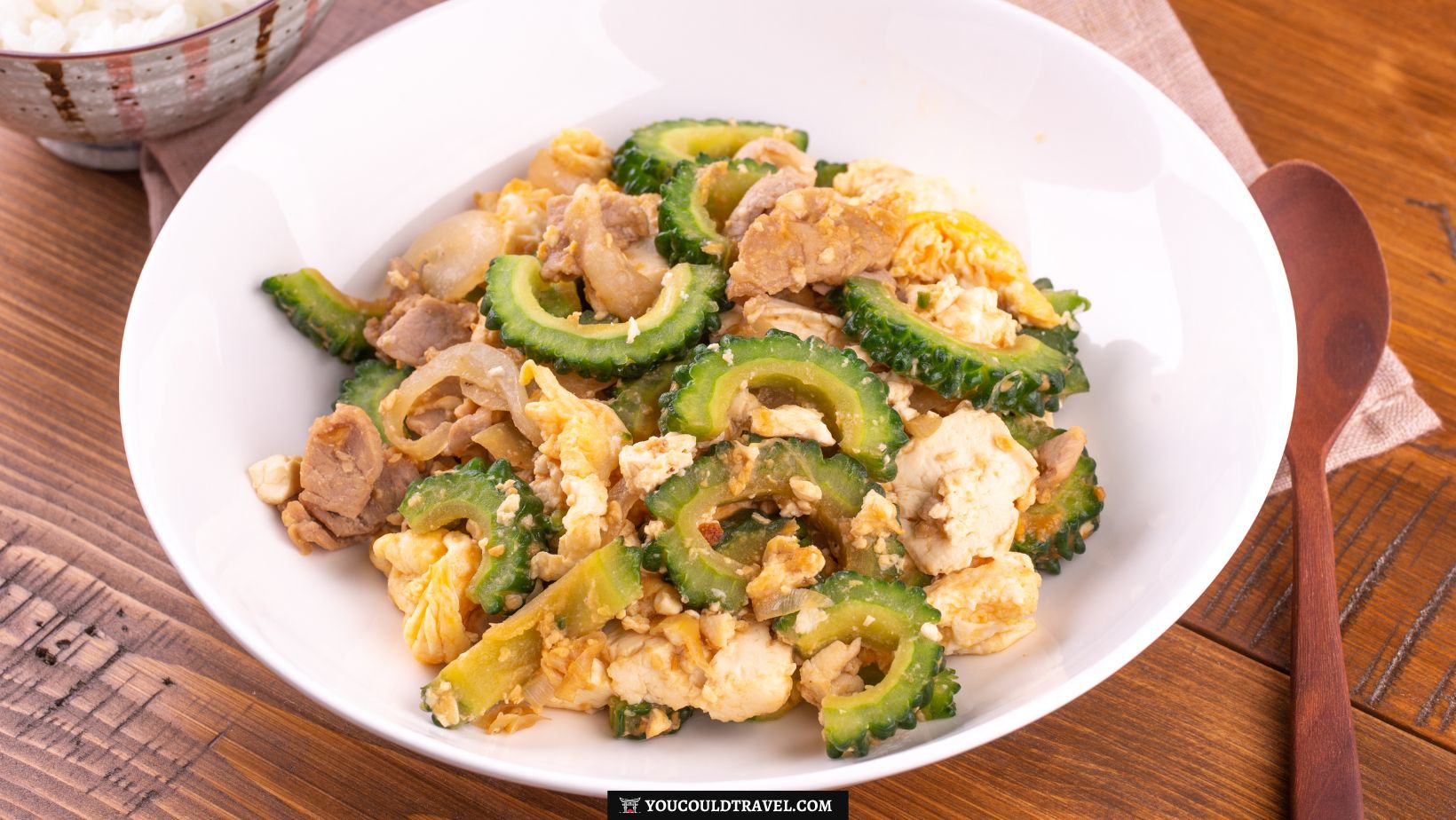
ōyā Champuru is a popular Okinawan dish that features goya, or bitter melon, as its main ingredient. The goya is stir-fried along with tofu and pork, creating a savoury and slightly bitter taste profile. The dish is seasoned with bonito flakes and soy sauce, which add depth and umami to its flavour. Goya is often referred to as the ‘king of summer vegetables’ in Okinawa due to its high vitamin content and its bitterness, which is believed to stimulate the appetite during the hot summer months.
The tofu used in Gōyā Champuru is typically Okinawan-style, known for its firm texture and rich soy flavour. This type of tofu can maintain its shape during the cooking process, making it an ideal component for stir-fried dishes. The versatility of Gōyā Champuru allows for various adaptations, such as incorporating somen (Japanese thin flour noodles) to create Somen Champuru, or adding fu (wheat gluten cakes) to make Fu Champuru.
Beni Imo
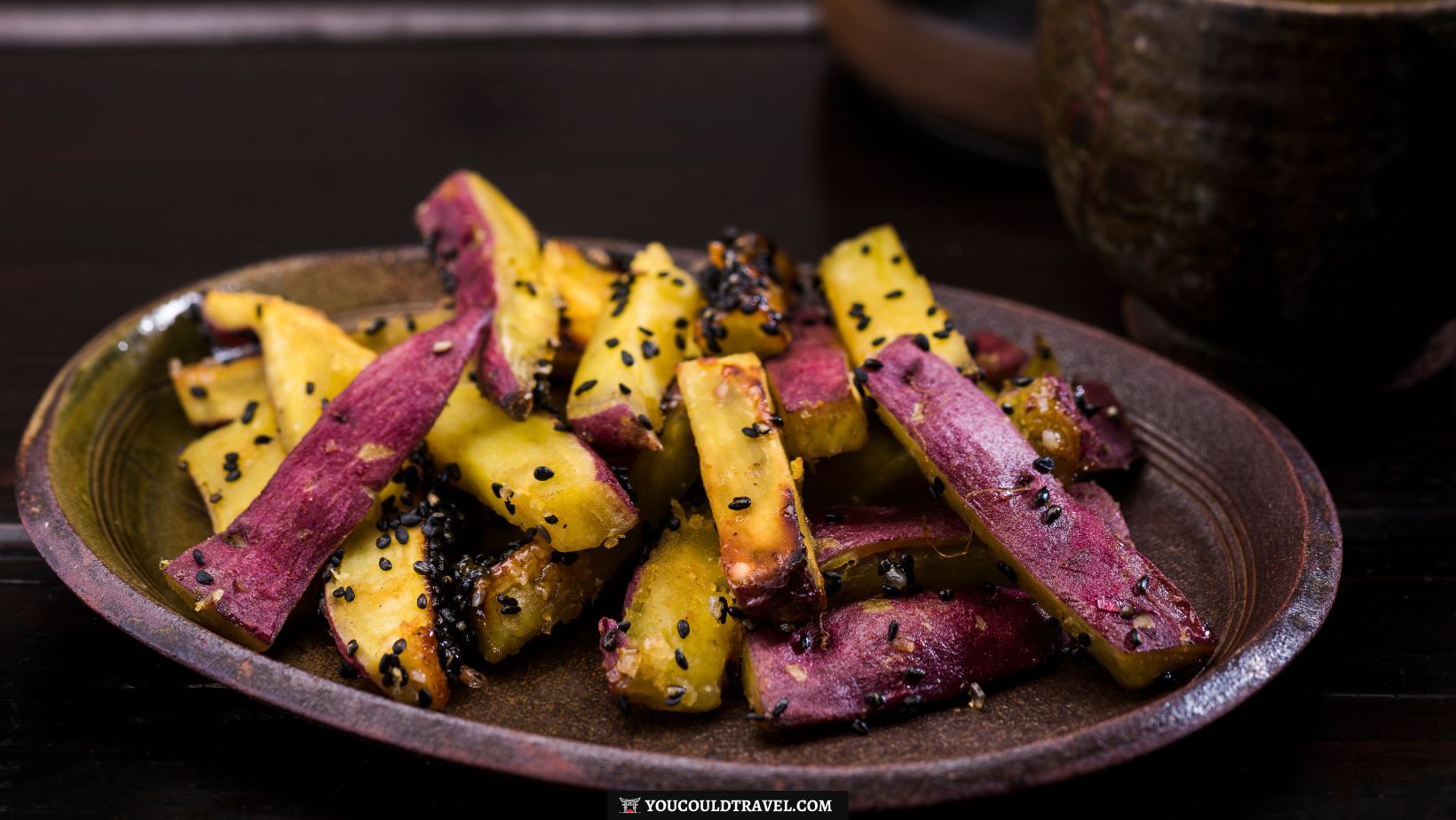
Beni Imo is a special variety of purple sweet potato native to Okinawa. The most distinctive feature is its deep purple flesh. The skin is usually purple too. These sweet potatoes have a sweet and slightly nutty flavour. But it’s milder and less sugary than regular orange-fleshed sweet potatoes.
You will find Beni Imo incorporated in just about everything, ranging from main dishes to desserts and ice cream. Common preparations include mashed sweet potatoes, tempura, fries, and even desserts like pies and ice cream. When we had a traditional Okinawan lunch we even got it served as a delicious mini smoothie.
You will find it roasted and ready to eat as street food or, my favourite, as Benimo Tart which is the number one Okinawan sweet treat and snack from Okashi Goten.
Jūshī (Rice Dish)
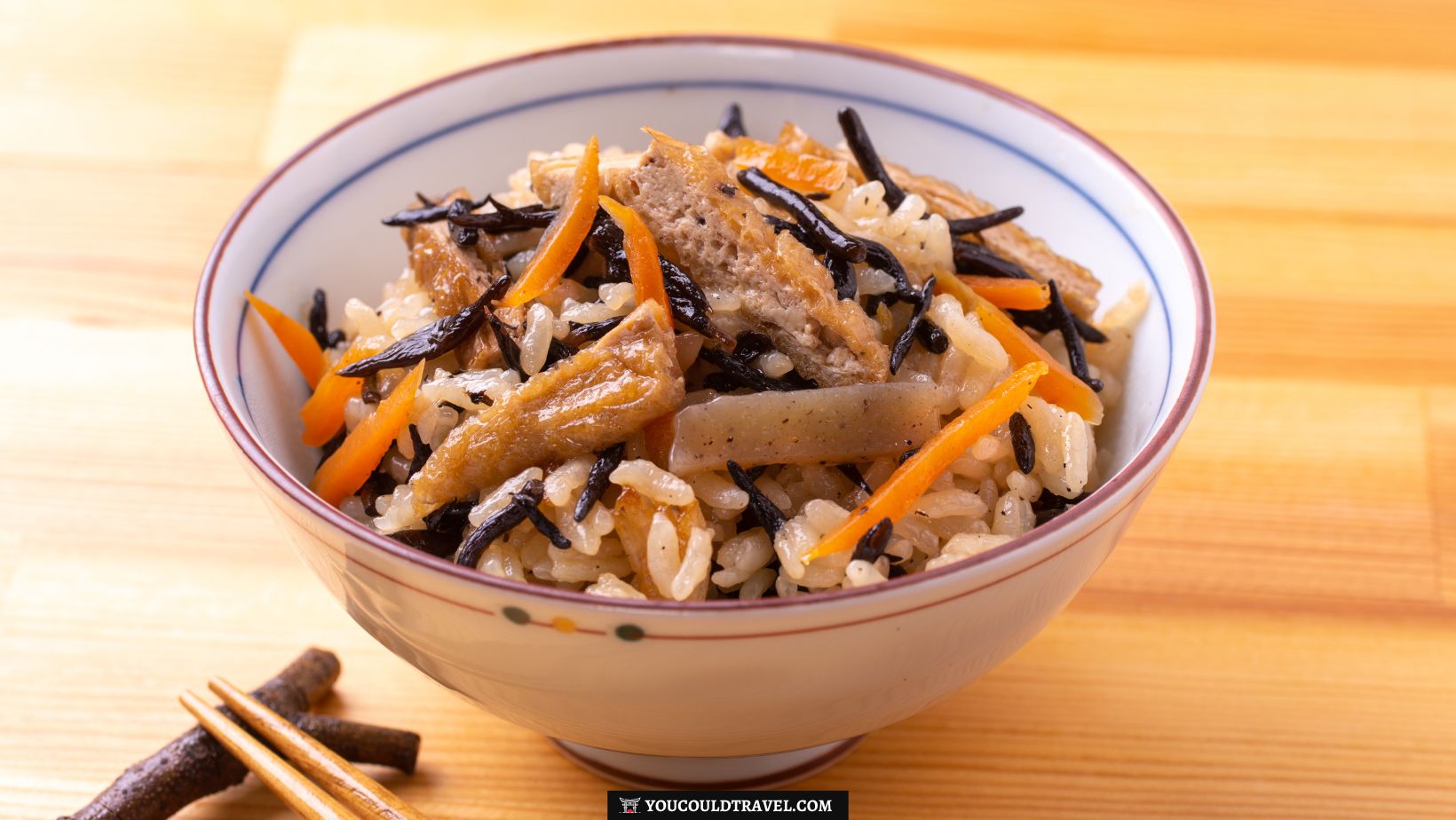
Jūshī, also known as Jūshi, is a classic Okinawan rice dish known for its simplicity and comforting flavours. It is essentially a seasoned rice dish, often compared to the Japanese pilaf, cooked with a mix of ingredients that can include vegetables, meat, and sometimes seafood. The base of Jūshī is a flavourful broth made from dashi (a Japanese stock) and awamori (an Okinawan distilled liquor), which infuses the rice with a deep umami taste.
The dish can be prepared with whatever ingredients are on hand, making it a staple in Okinawan households. Common additions include carrots, green beans, konbu (kelp), and pork, but some local restaurants make it with anything from chicken to tofu, and even Spam.
Rafute (Shoyu Pork)
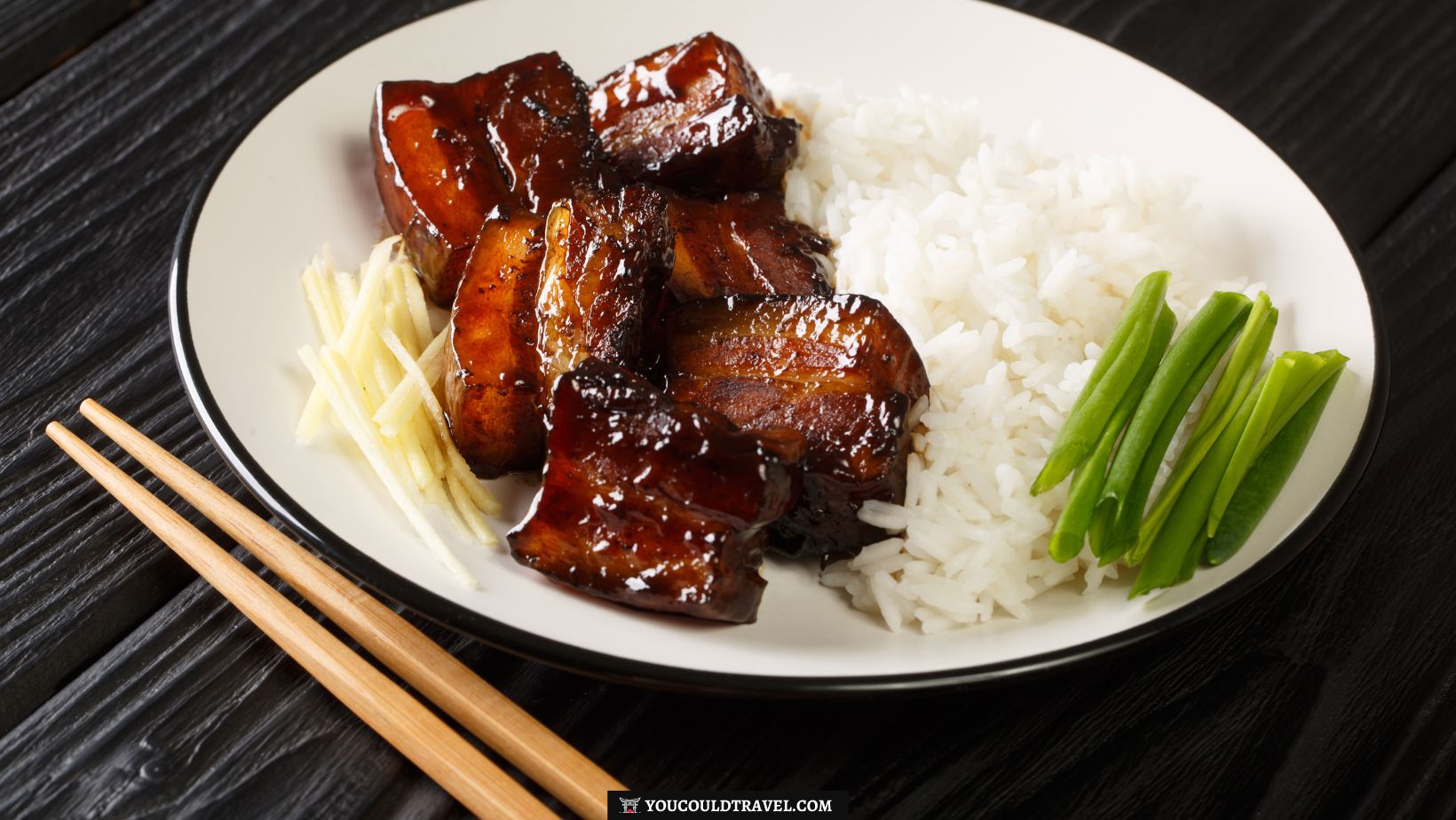
Rafute, also known as Shoyu Pork, is a popular dish from Okinawa made with pork belly. The preparation of Rafute begins with the pork belly being carefully braised until tender. The braising liquid is the key component and is made from a combination of shoyu (soy sauce), mirin (a sweet rice wine), sake, sugar, and awamori.
The cooking makes the pork really tender, so it almost falls apart. It’s served with rice and vegetables, making a filling meal. Rafute is a favourite in Okinawa, especially at special events, showing how much people there love this dish. It’s known for its rich taste and how it melts in your mouth.
Taco Rice
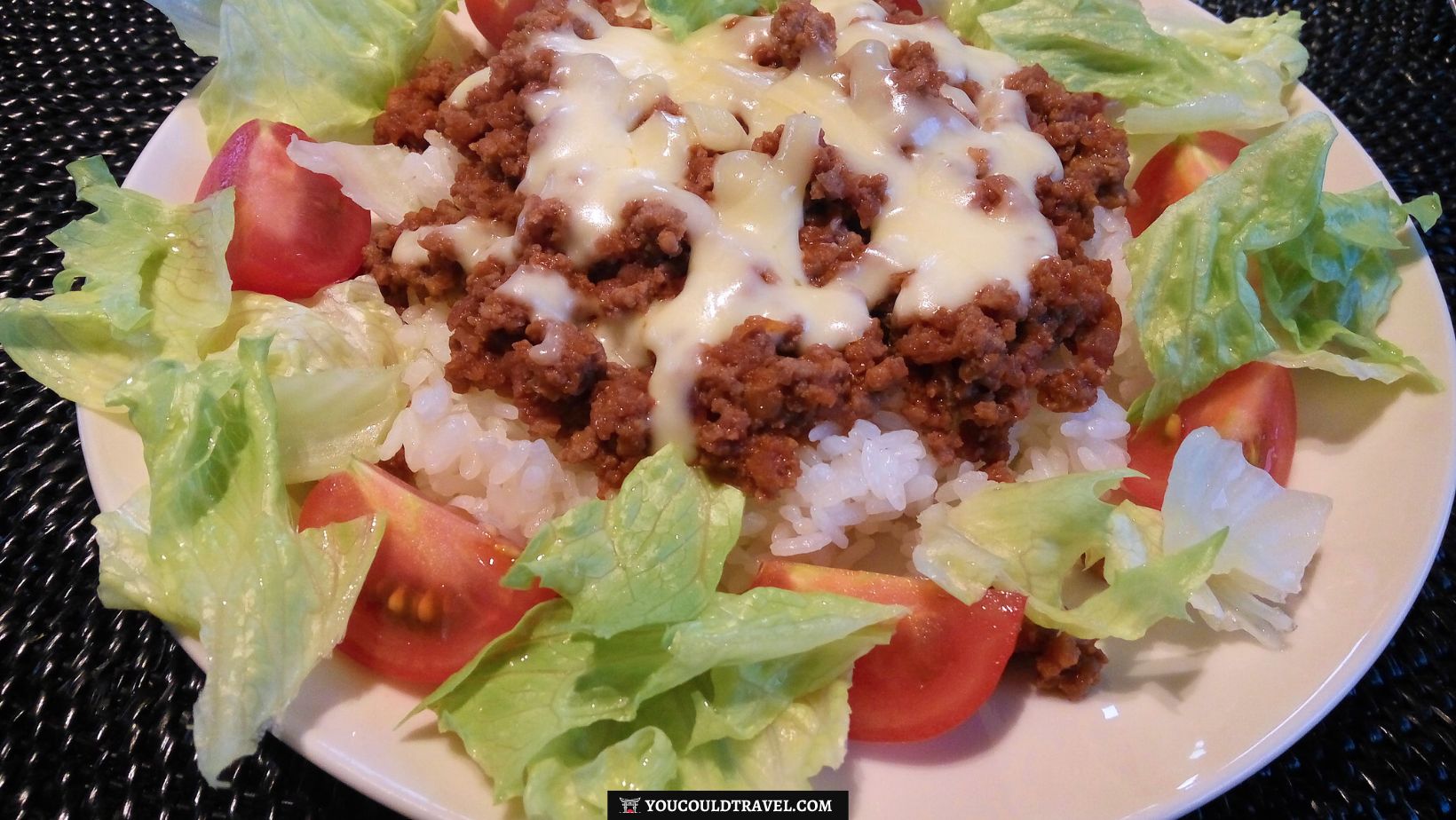
Taco Rice is an inventive dish from Okinawa that combines elements of Mexican tacos with Japanese cuisine. It was created to cater to the tastes of American military personnel stationed in Okinawa, mixing the familiar flavours of taco fillings with a staple of Japanese meals: rice. It might sound unusual but stay with me, it’s actually a delicious meal!
The dish starts with a bed of steamed rice, topped with seasoned ground beef similar to what you’d find in a taco. This is then garnished with shredded lettuce, cheese, and diced tomatoes. Some versions might also include salsa, sour cream, or even guacamole to enhance the taco experience.
Minudaru (Steamed Pork Loin)
Minudaru is a traditional Okinawan dish featuring steamed pork, known for its tender texture and subtle flavours. The pork is gently seasoned and then steamed, a method that preserves its natural juiciness and allows the seasoning to infuse deeply into the meat.
The seasoning for Minudaru includes a mix of soy sauce, sake, and local Okinawan spices or sugar. The slow steaming process ensures that the pork remains moist and tender, making it easy to slice and serve. The best part? Minudaru is usually covered in black sesame sauce, then served with rice and vegetables.
Soki Soba (Pork Ribs Soba)
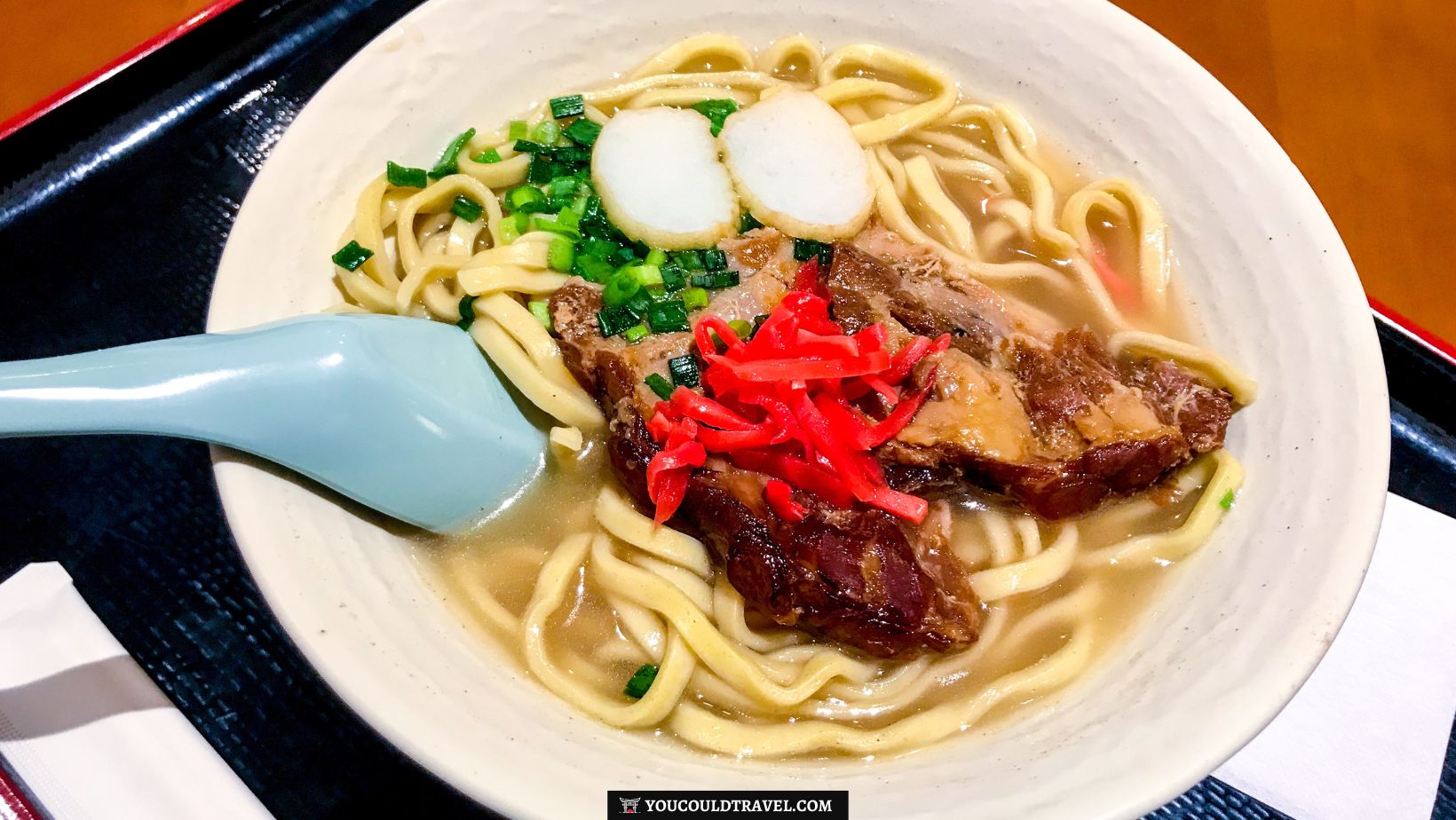
Soki Soba is a beloved noodle dish from Okinawa that features tender, slow-cooked pork ribs (soki) served on top of Okinawa-style soba noodles. Remember, as mentioned above, Okinawa-style noodles are made from wheat flour and resemble udon in their thickness and chewiness.
The pork ribs are stewed until they are so tender that the meat easily comes off the bone. Same staple local ingredients are used for the broth: soy sauce, mirin, and sometimes sake or awamori. The broth is then used for the noodle soup. Yum!
Soki Soba is garnished with green onions and pickled ginger.
Mimigā (Pig’s Ear)
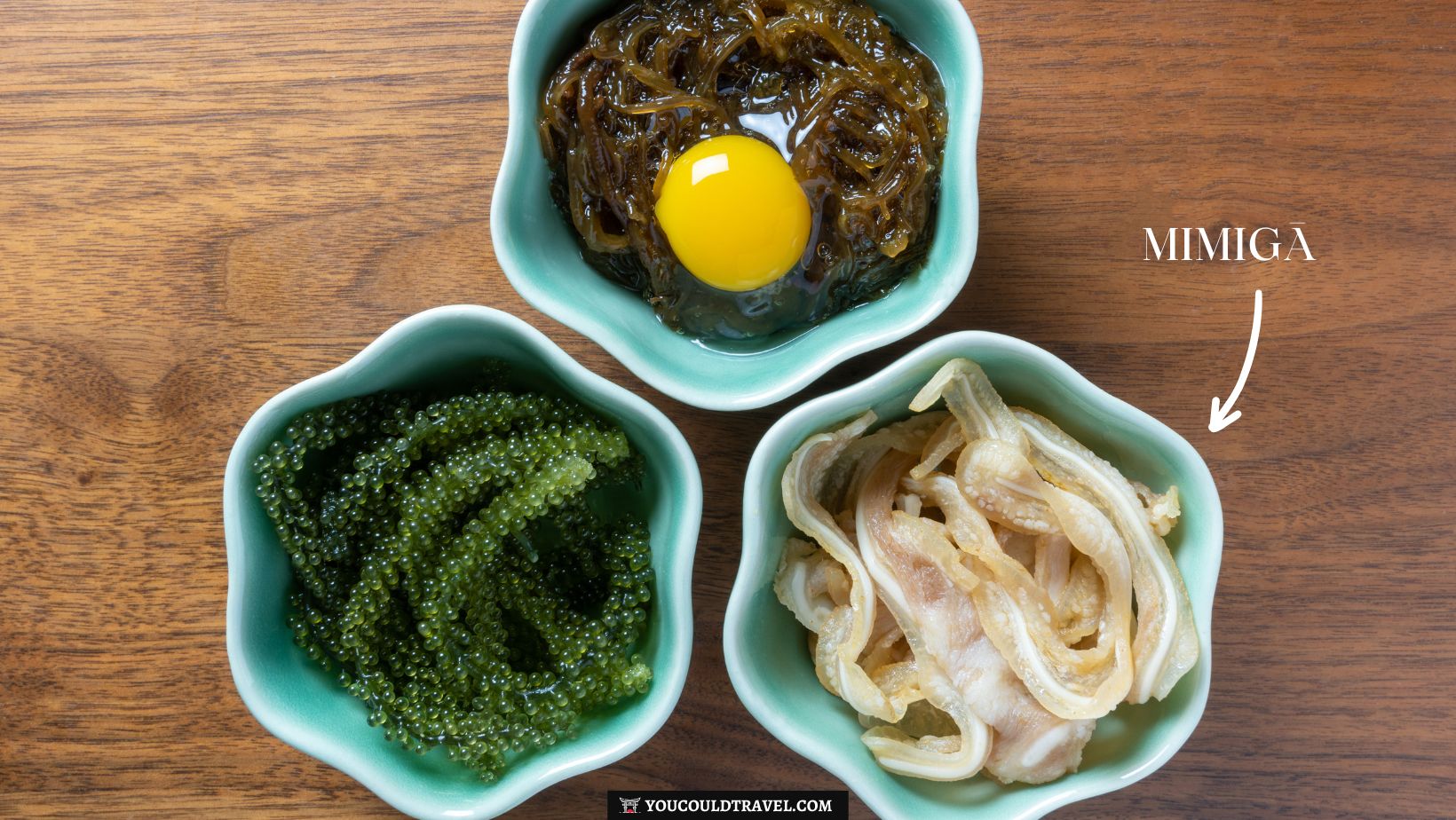
Mimigā is an Okinawan dish made from thinly sliced pig’s ears, that have a very distinctive crunchy and chewy textures. The pig’s ears are boiled to soften them and then marinated in a blend of soy sauce, vinegar, and either sesame oil or peanut sauce. This preparation gives Mimigā a savoury and slightly tangy flavour.
Served as a side dish or appetizer, Mimigā shows that Okinawan people like utilizing all parts of the pig.
Umi-budō (Sea Grapes)
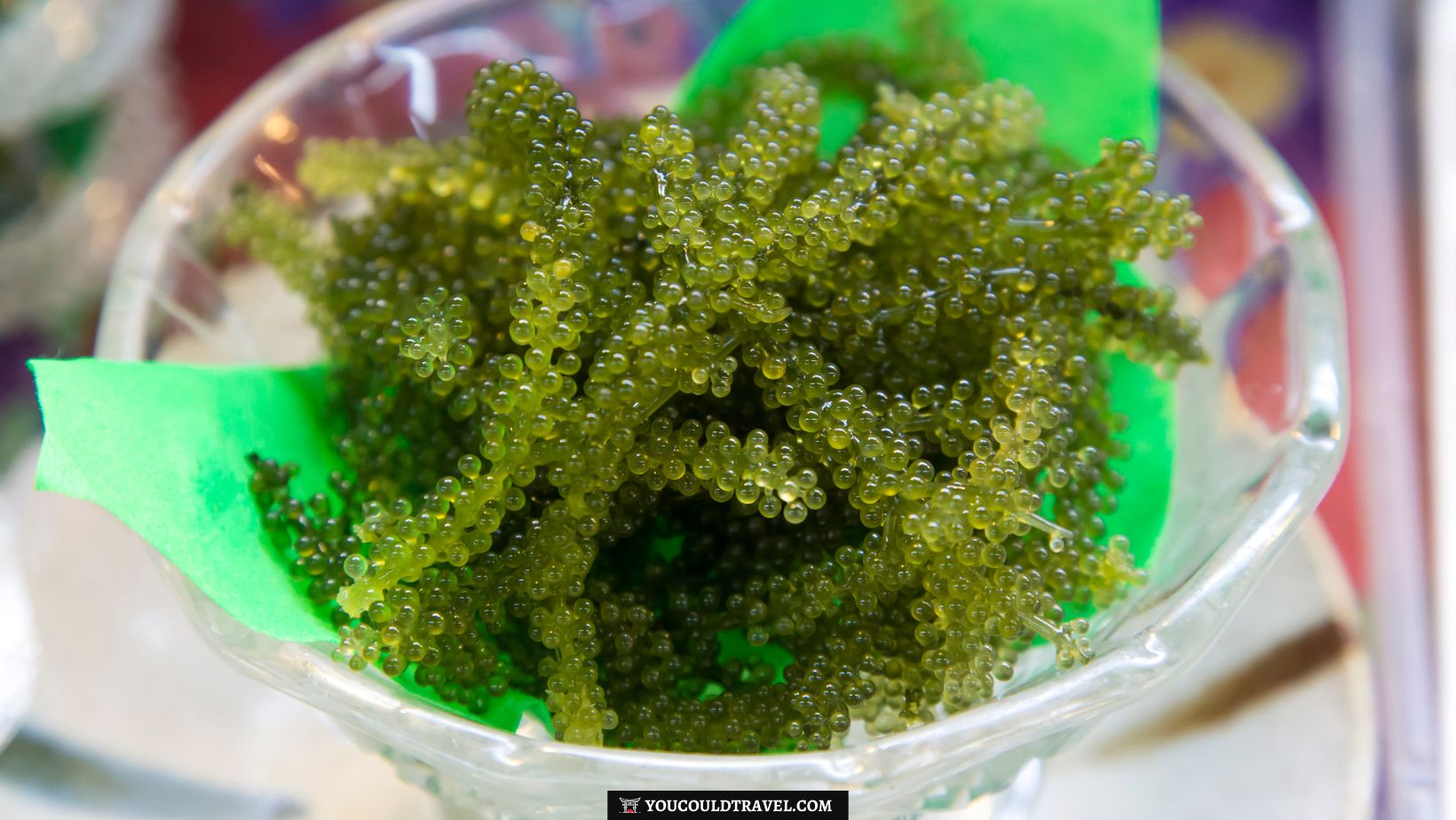
Umi-budō, known as sea grapes or green caviar, is a type of seaweed that’s a delicacy in Okinawa. It looks like small green beads clustered together, resembling tiny grapes. It’s my top Okinawan food to eat, so I recommend it with just about everything. Umi-budō has a fresh, salty taste and a popping texture when you eat it.
This seaweed is served raw as a garnish or in salads, and is enjoyed with a dip of soy sauce or vinegar to enhance its natural ocean flavour. There is an Okinawan store in Tokyo called Ginza Washita that usually sells it as well.
Hirayachi
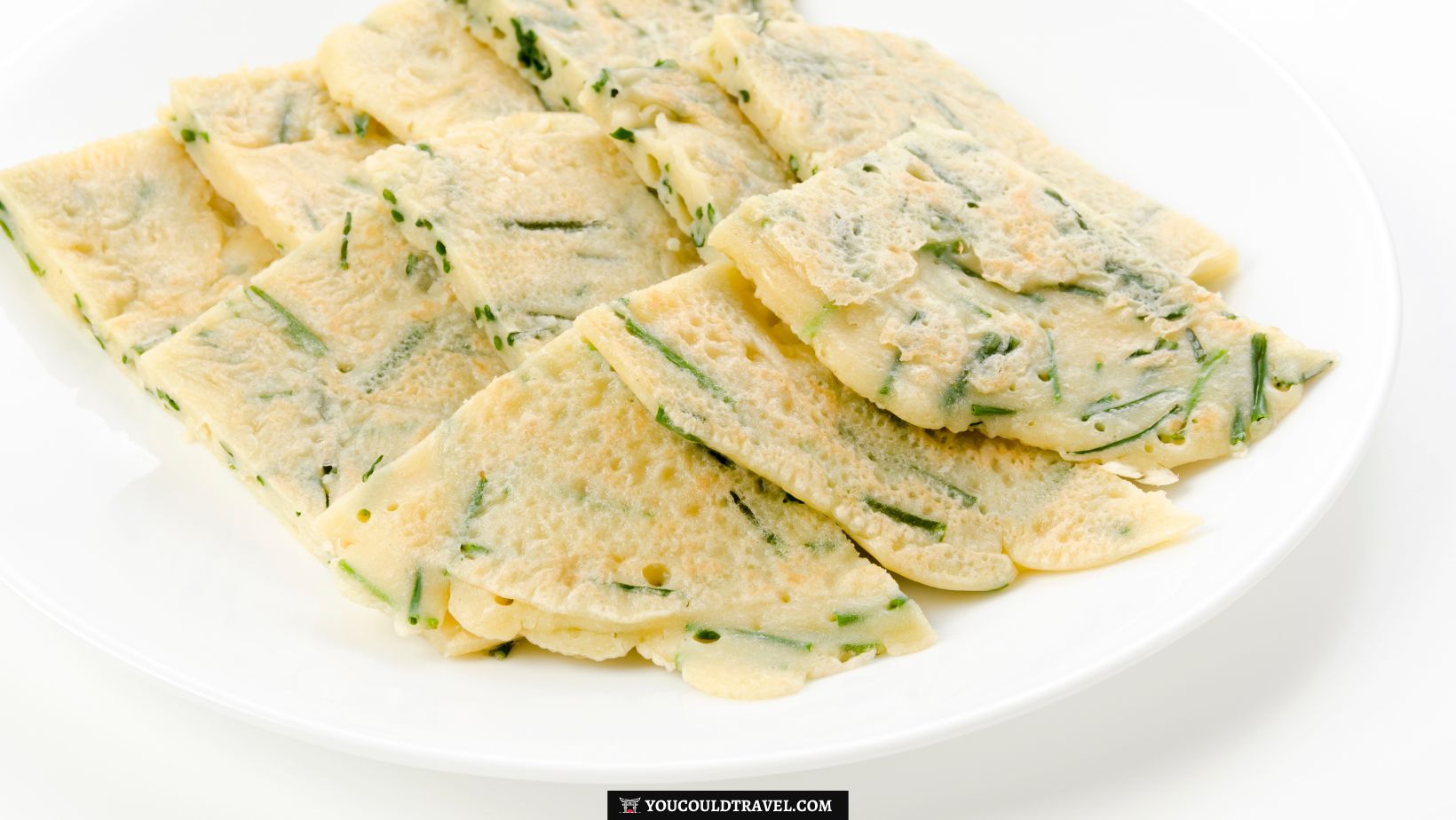
Hirayachi is an Okinawan pancake that’s simple and savoury. It is made with a batter of eggs, flour, water, and chopped green onions, Hirayachi is similar to a thicker version of a crêpe or a less fluffy version of an American pancake. The batter is seasoned with salt, then fried in a pan until golden brown on both sides. Our hotel served it for breakfast, and chances are, most hotels in Okinawa will have it as a breakfast dish.
Tofuyo
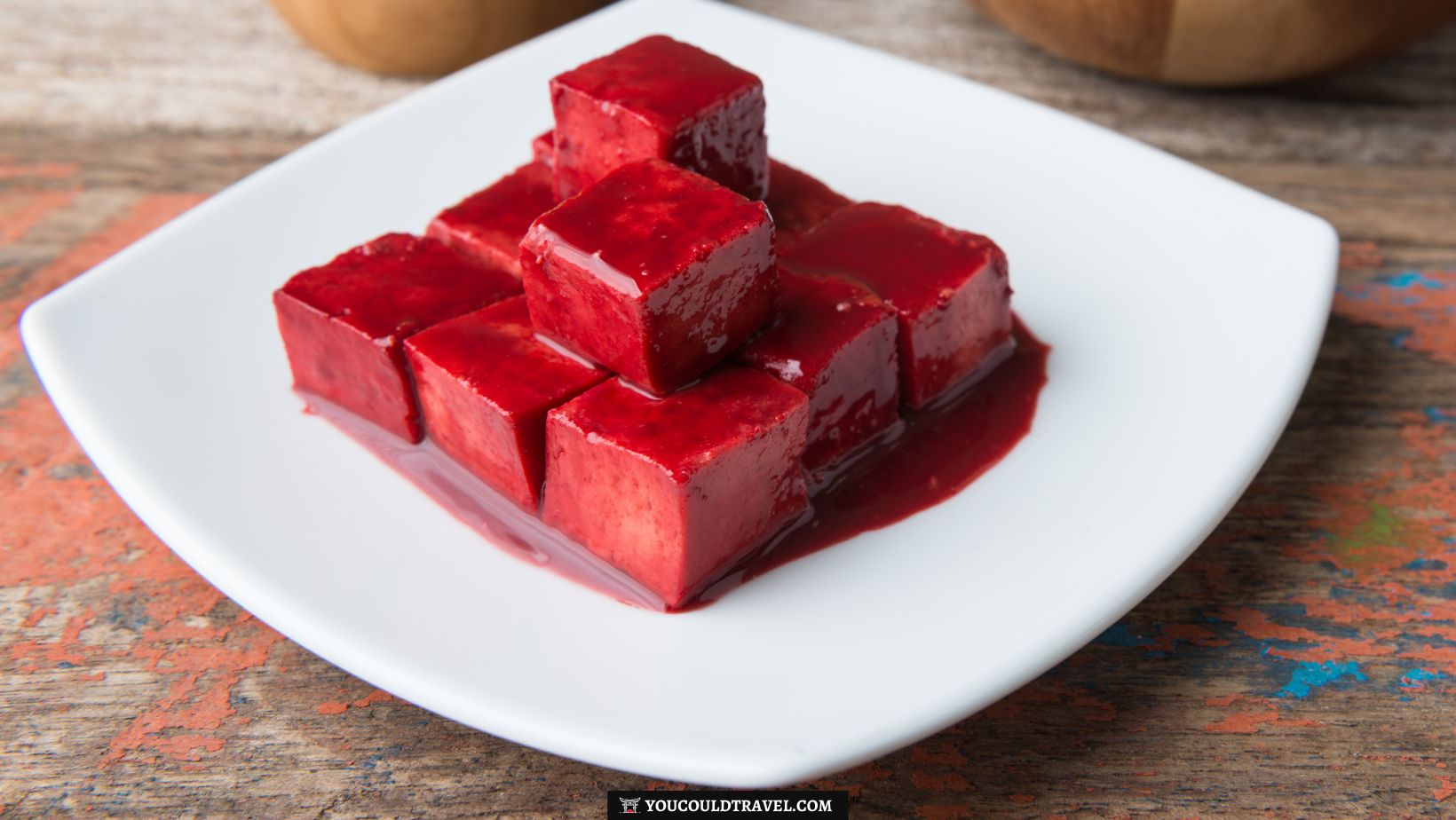
Tofuyo is a fermented tofu dish, with a strong, cheese-like flavour and creamy texture. It’s made by fermenting tofu with red koji mold, awamori, and salt. The fermentation process transforms the tofu into a soft, spreadable delicacy with a distinct taste that’s often compared to a fine cheese.
Tofuyo is especially delicious for breakfast, when spread on a little toast with an egg on top. At least this is how I like to eat it.
Sukugarasu
Sukugarasu is made from tiny salted fish, specifically the fry of the rabbitfish, which are fermented and served as a topping on tofu or mixed into dishes for added flavour. The fish are intensely salty and have a strong oceanic flavour, with a texture that contrasts with the soft tofu they’re typically paired with. Sukugarasu is a side dish, perfect when accompanied by a drink of awamori.
Yushi Dofu
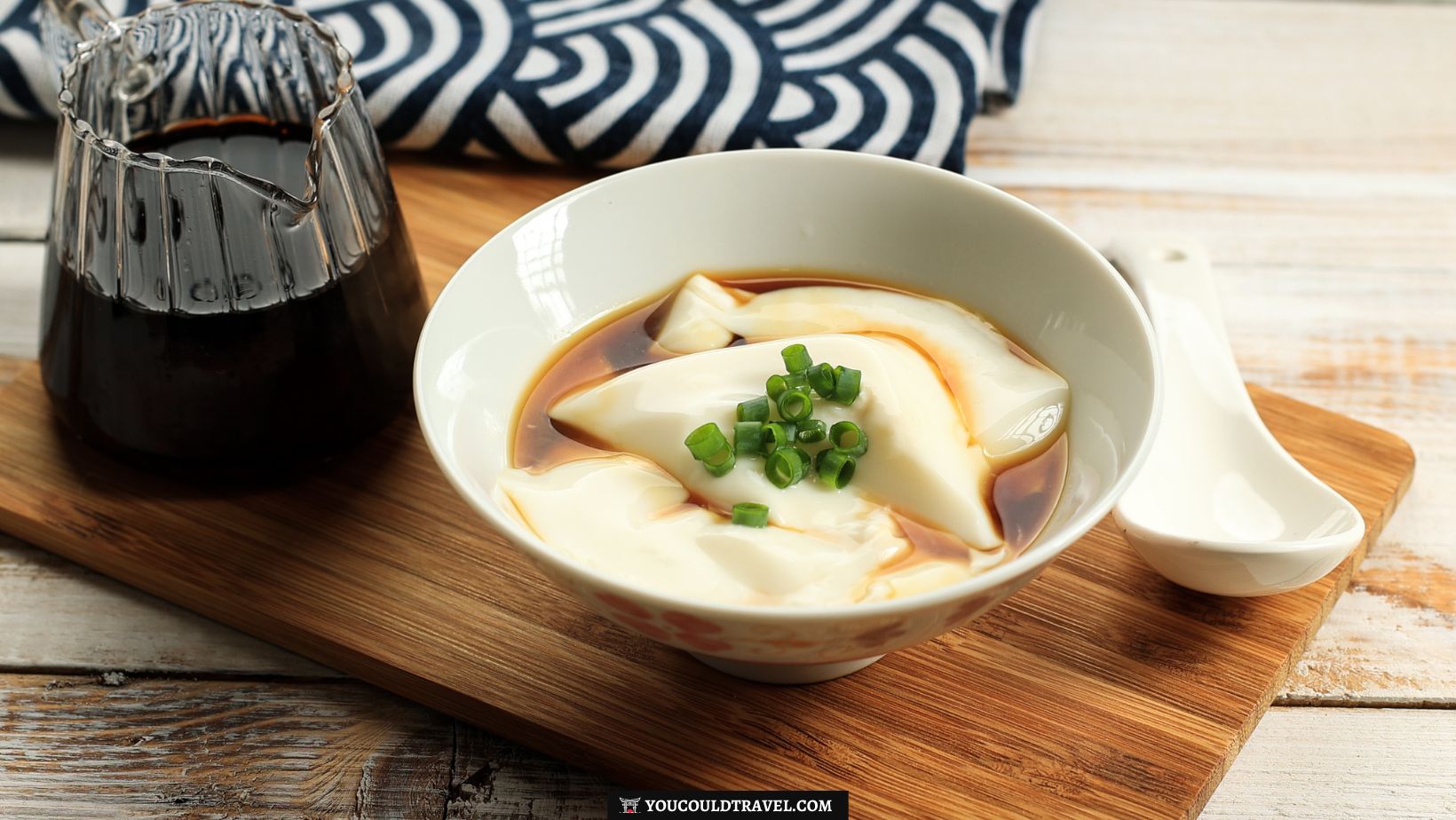
Yushi Dofu is a very soft type of tofu from Okinawa. It’s not pressed like regular tofu, so it stays really creamy and soft. People in Okinawa like to eat it in a simple way, often just with some soy sauce or in a light soup, to enjoy its fresh soy taste.
It’s a special kind of tofu that’s different from the firmer tofu you might be used to. You will find this sold in almost every Okinawan food store.
Abura Miso
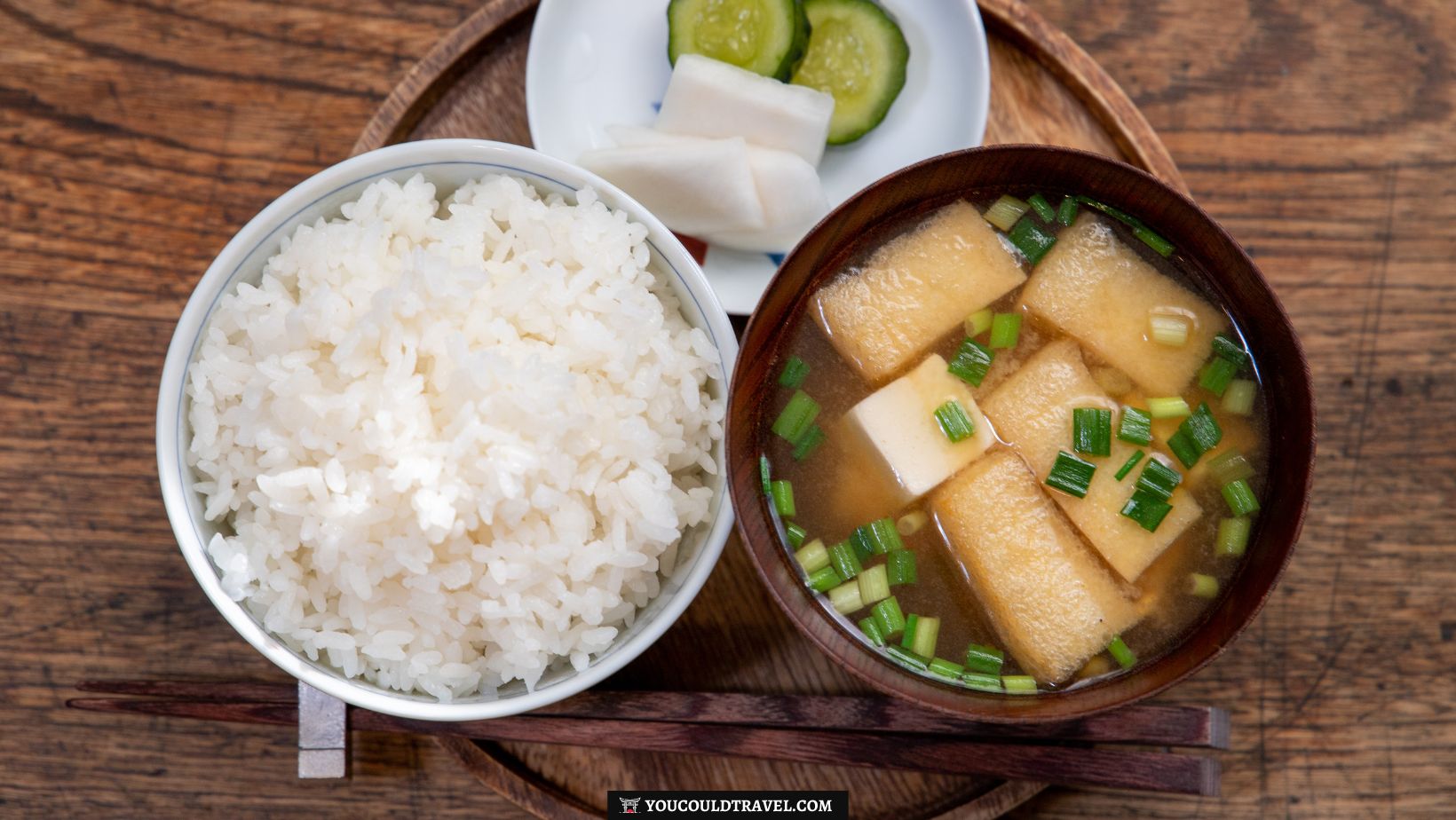
Abura Miso is a special paste from Okinawa made by cooking miso (a kind of fermented soybean paste), pork, and sugar together. When they cook it, the pork gets really soft and the sugar adds a little sweetness to the miso, making a thick, tasty paste.
The exact recipe and consistency can vary from one household to another, with some variations including additional ingredients like sake, mirin, and awamori to enhance the flavour. Abura Miso is used as a hearty spread over steamed rice, as a filling for onigiri (rice balls), or as a flavourful dip for raw or cooked vegetables.
Chinsuko (Okinawan Cookie)
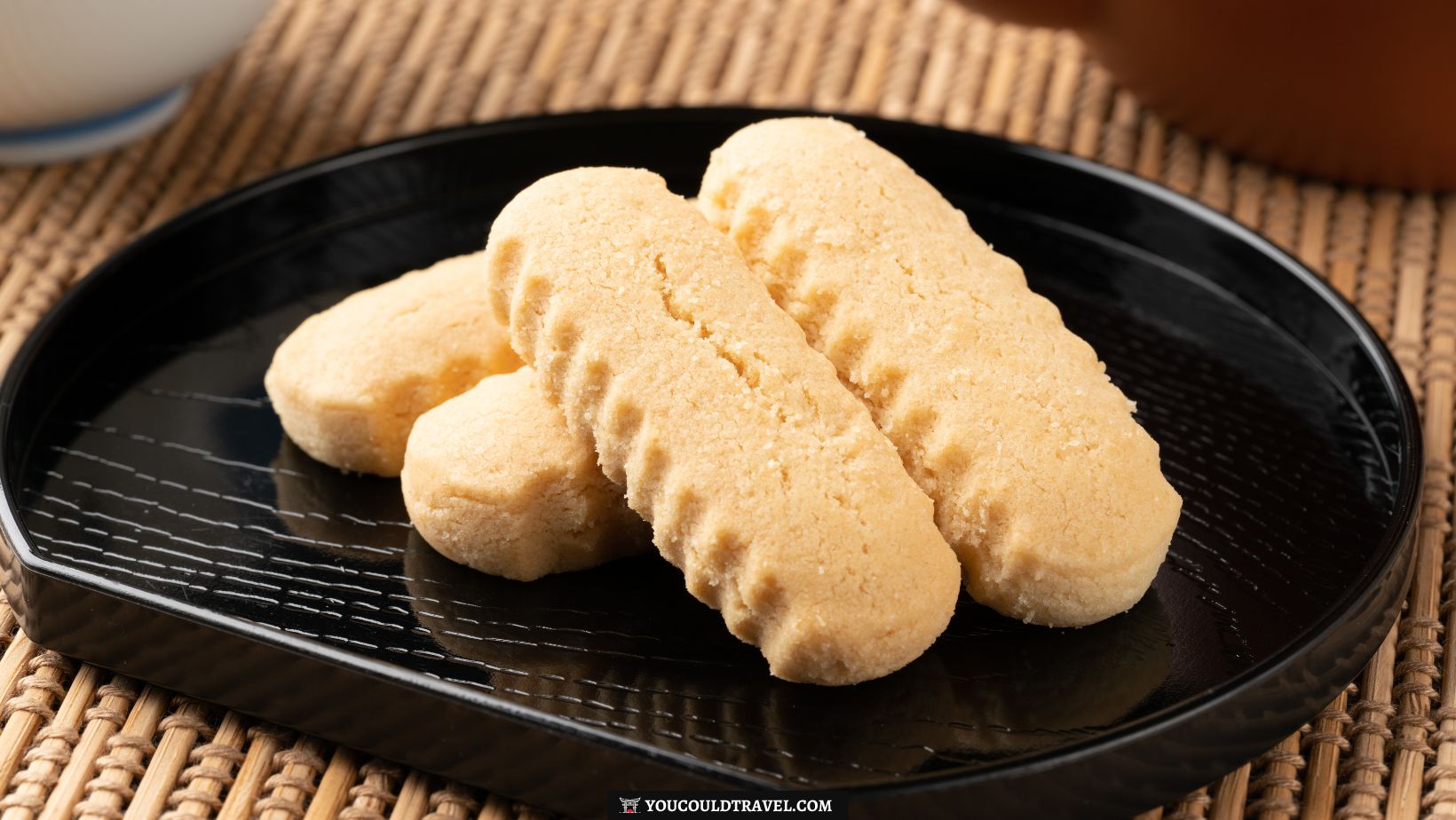
Chinsuko is a traditional Okinawan cookie that’s similar to shortbread. It’s made from flour, sugar, and lard, giving it a light, crumbly texture. These cookies are often enjoyed as a snack or served with tea. Chinsuko has a mild sweetness and a buttery flavour, making it a popular treat in Okinawa and a common souvenir for visitors to the islands.
You will find pineapple Chinsuko at the Nago Pineapple Park and mango Chinsuko at the Okinawa World. I recommend both as delicious gifts for your loves ones.
Fuchagi
Fuchagi is a traditional Okinawan sweet treat made from mochi (a Japanese rice cake) shaped as an oblong then topped with sweetened red bean paste. It’s similar to the well-known Japanese dessert daifuku, but Fuchagi has its own unique Okinawan twist, incorporating local ingredients such as purple sweet potatoes or black sugar to enhance the flavour.
The outer layer of Fuchagi is made from glutinous rice that’s pounded into a soft and chewy texture, shaped into an oblong, creating a perfect blank canvas for the sweet bean topping. Fuchagi is commonly enjoyed during celebrations and festive occasions in Okinawa when locals offer it to the Gods.
Jīmami Dōfu (Peanut tofu)
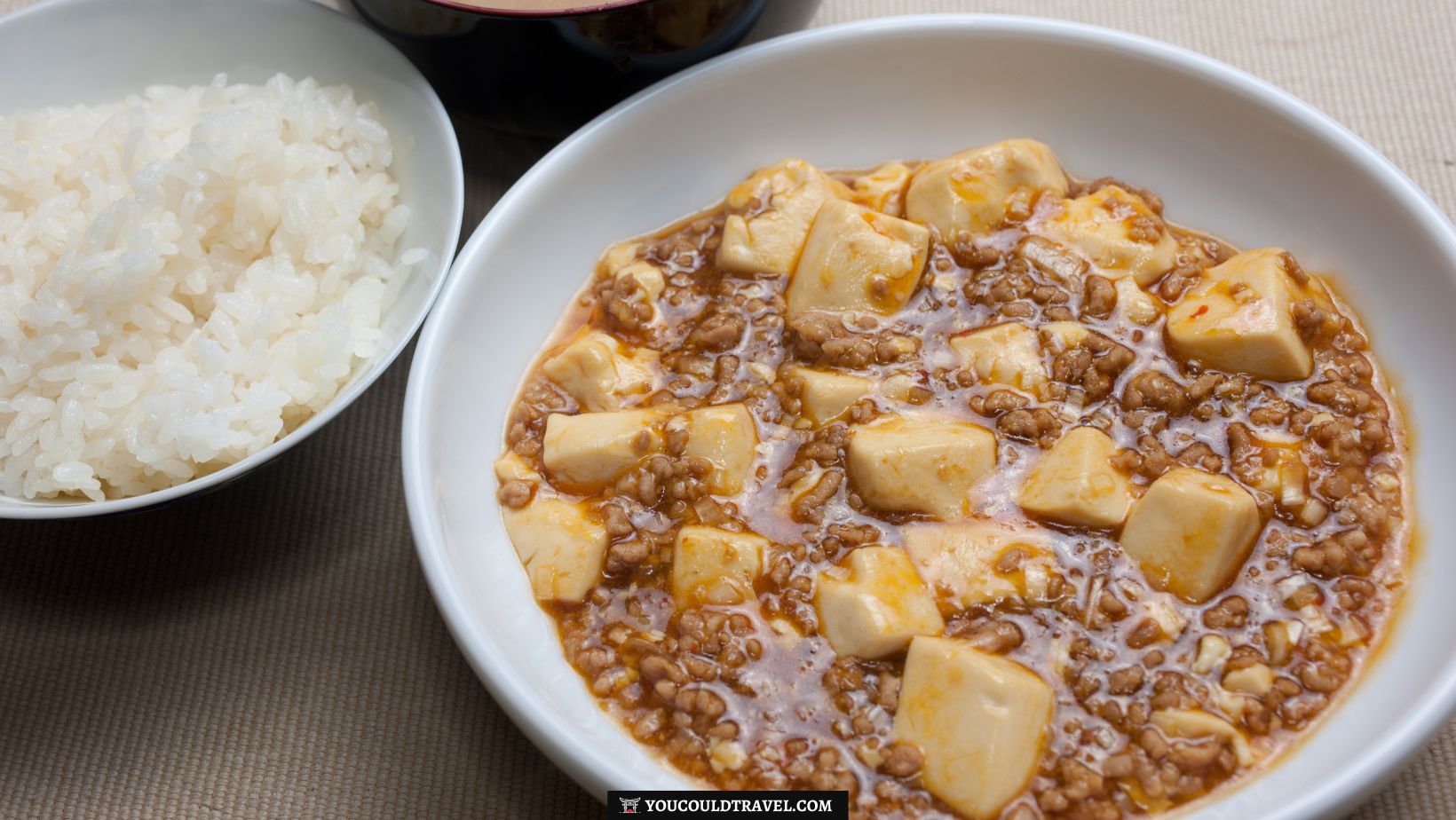
Jīmami Dōfu is a unique Okinawan dish that resembles tofu but is actually made from peanuts. It’s a smooth, jelly-like food that combines the creamy texture of tofu with the rich, nutty flavour of peanuts. To make Jīmami Dōfu, peanut paste is mixed with water, sugar, and a coagulant, then set until it achieves a firm, custard-like consistency.
This dish is enjoyed as a dessert and it’s fantastic especially in the summer when Jīmami Dōfu is served chilled, with a drizzle of syrup or kinako (roasted soybean flour).
Sata Andagi
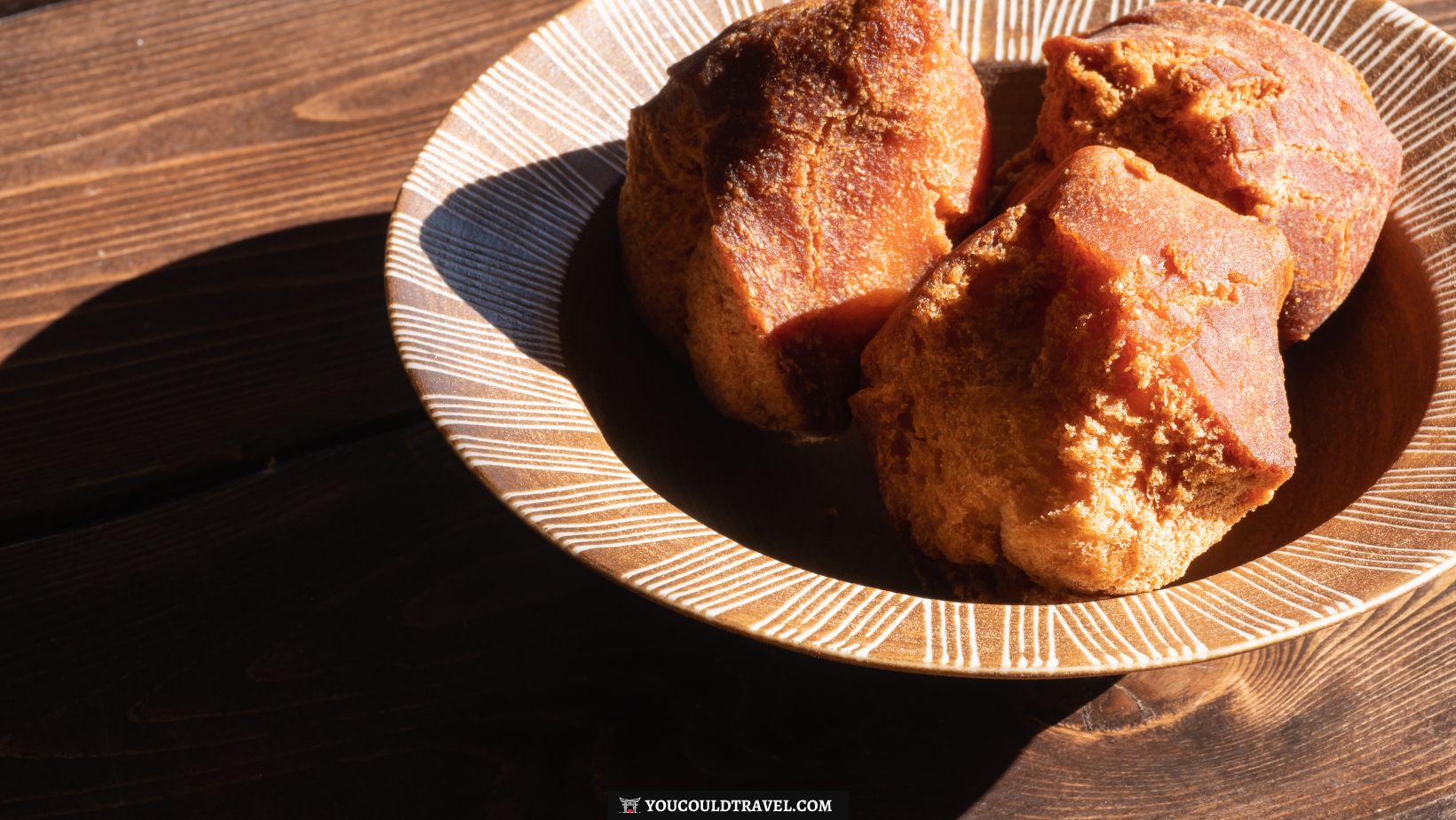
Sata Andagi are essentially Okinawan doughnuts. They are deep-fried balls of dough, with crispy outer layer and dense, cake-like interior. The basic ingredients include flour, sugar, and eggs, which are mixed together to form a thick batter. This batter is then shaped into small balls and deep-fried until they turn a golden brown colour.
You’ll find that Sata Andagi are a common feature at local festivals and celebrations in Okinawa, but they have become a popular snack. To eat them, head to Ryukyu Kashi-Dokoro Ryugu in Naha or Matsuhara Confectionary located in the Makishi Public Market.
Muchi
Muchi is a Japanese sweet, different from mochi. It’s from Okinawa and made with a special kind of rice flour. It’s chewy and usually filled with sweet red bean paste. Muchi is wrapped in shell ginger leaves that give it a nice smell.
Okinawan Brown Sugar
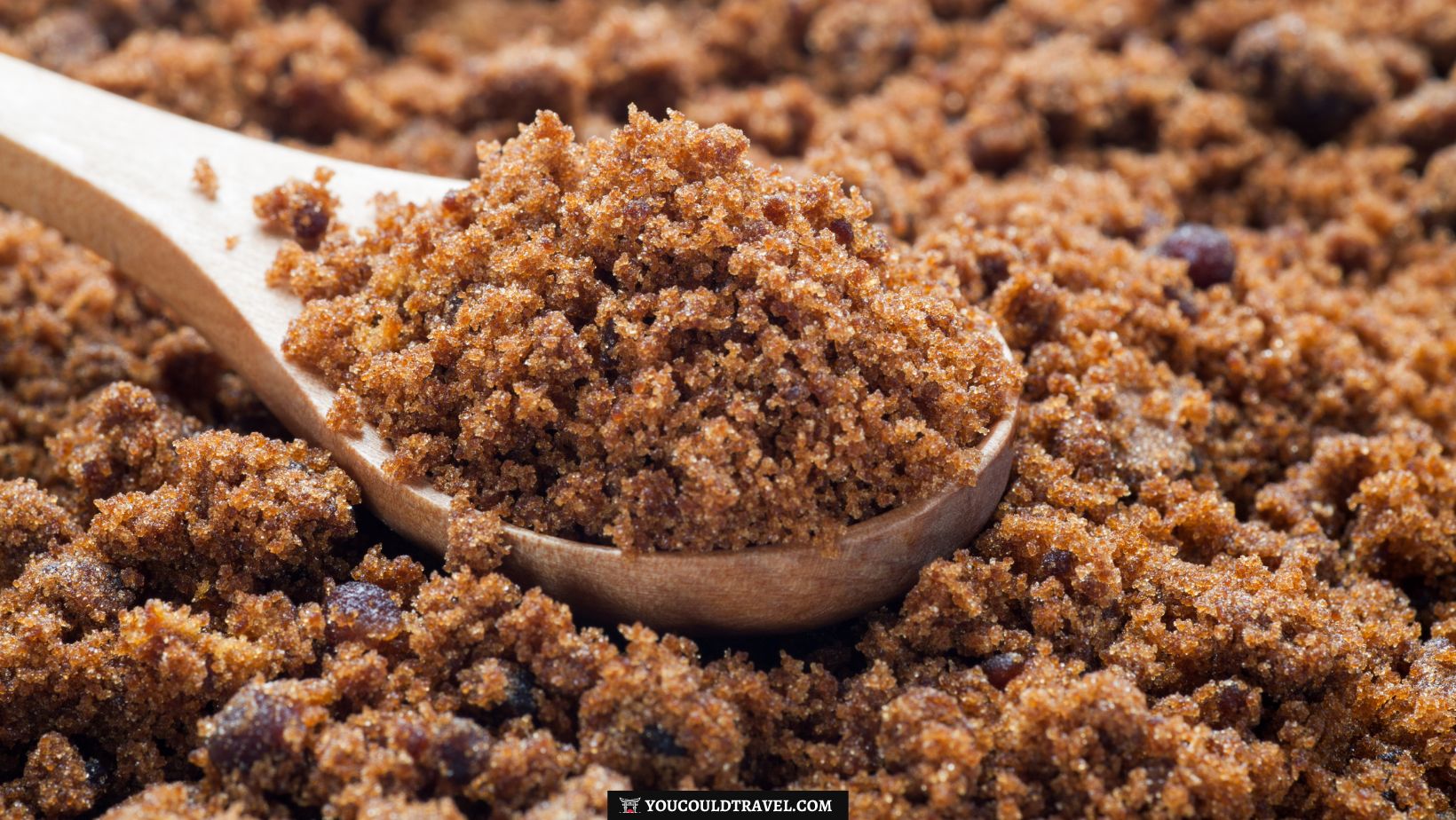
Okinawan brown sugar, known locally as “kokuto,” is a unique kind of sugar made in Okinawa. Unlike regular brown sugar, which is made from sugar cane juice with molasses added back, kokuto is made by slowly cooking sugar cane juice until it crystallizes. This process retains more of the natural minerals and nutrients found in sugar cane.
Kokuto has a deep, rich flavour, less sweet, with a slight molasses taste, and hints of caramel. It’s used in Japanese sweets and cooking, and believed to have health benefits, like aiding digestion and providing minerals.
Chinbin
Chinbin is a traditional Okinawan crepe-like dish, like a type of sweet pancake. It is made with simple ingredients: wheat flour, sugar, and water or milk. What makes Chinbin distinct is its texture and taste. It’s thinner than a typical pancake but thicker than a French crêpe, striking a balance between the two. It’s like a sweet version of the Hirayachi.
The sweetness of Chinbin comes from the sugar added to the batter, and it’s often enjoyed as a snack or dessert. In some variations, Okinawan brown sugar (kokuto) is used, giving the Chinbin a rich, caramel-like flavour unique to Okinawan cuisine.
Okinawa Ice Cream
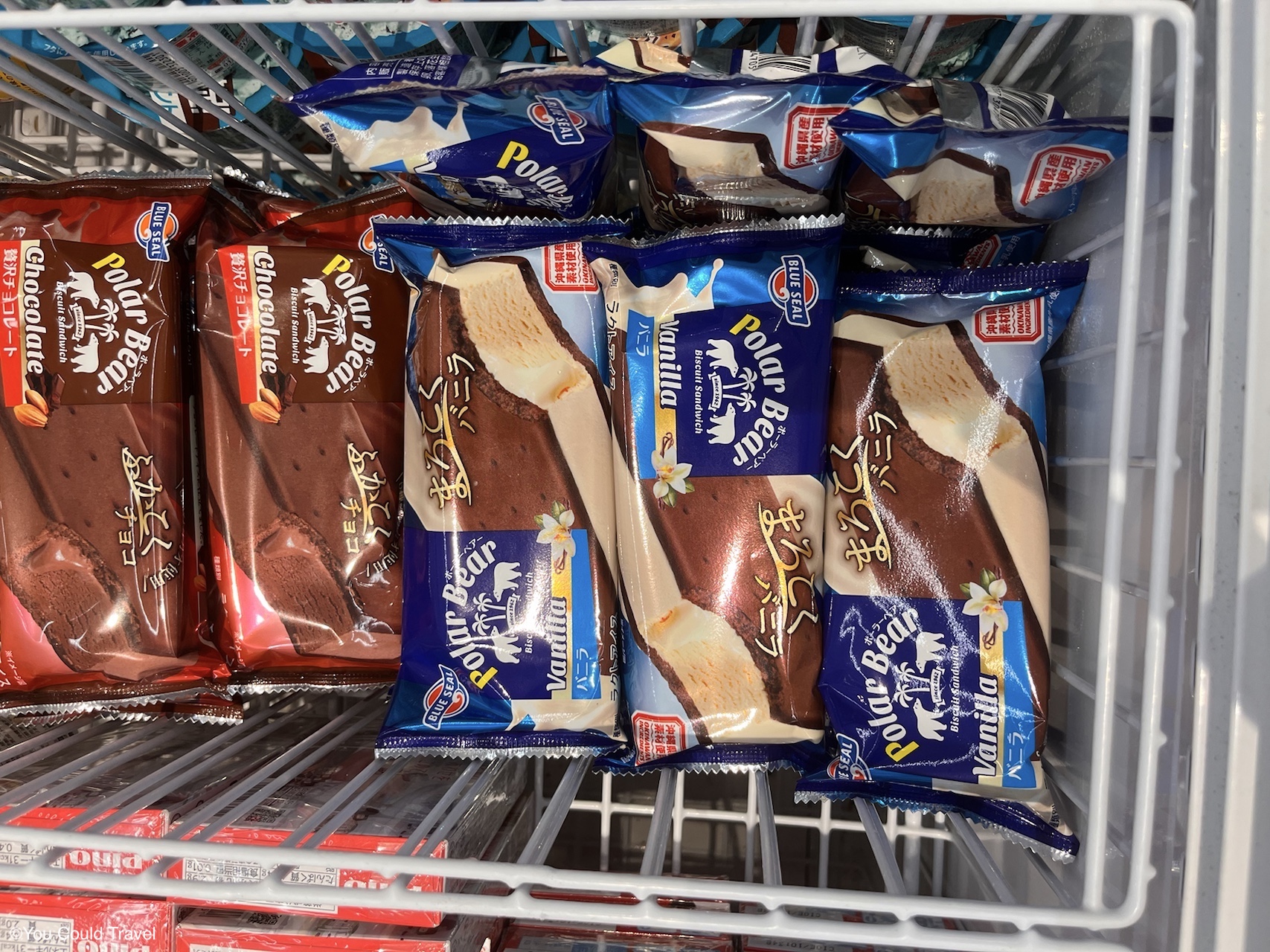
Blue Seal Ice Cream is a famous brand originating from Okinawa and yes, you can really find it everywhere here. It’s known for its fun range of flavours that reflect Okinawan culture and ingredients. Blue Seal began as an ice cream brand for American military bases in Okinawa, but eventually became a beloved ice cream brand among the Okinawan people and throughout Japan.
The flavours offered by Blue Seal are distinctive. They include Okinawan sweet potato, tropical fruit flavours like pineapple and mango, and even quirky ones like beni-imo (purple sweet potato), shikuwasa (a citrus fruit native to Okinawa), and salt cookies.
Shikuwasa Juice
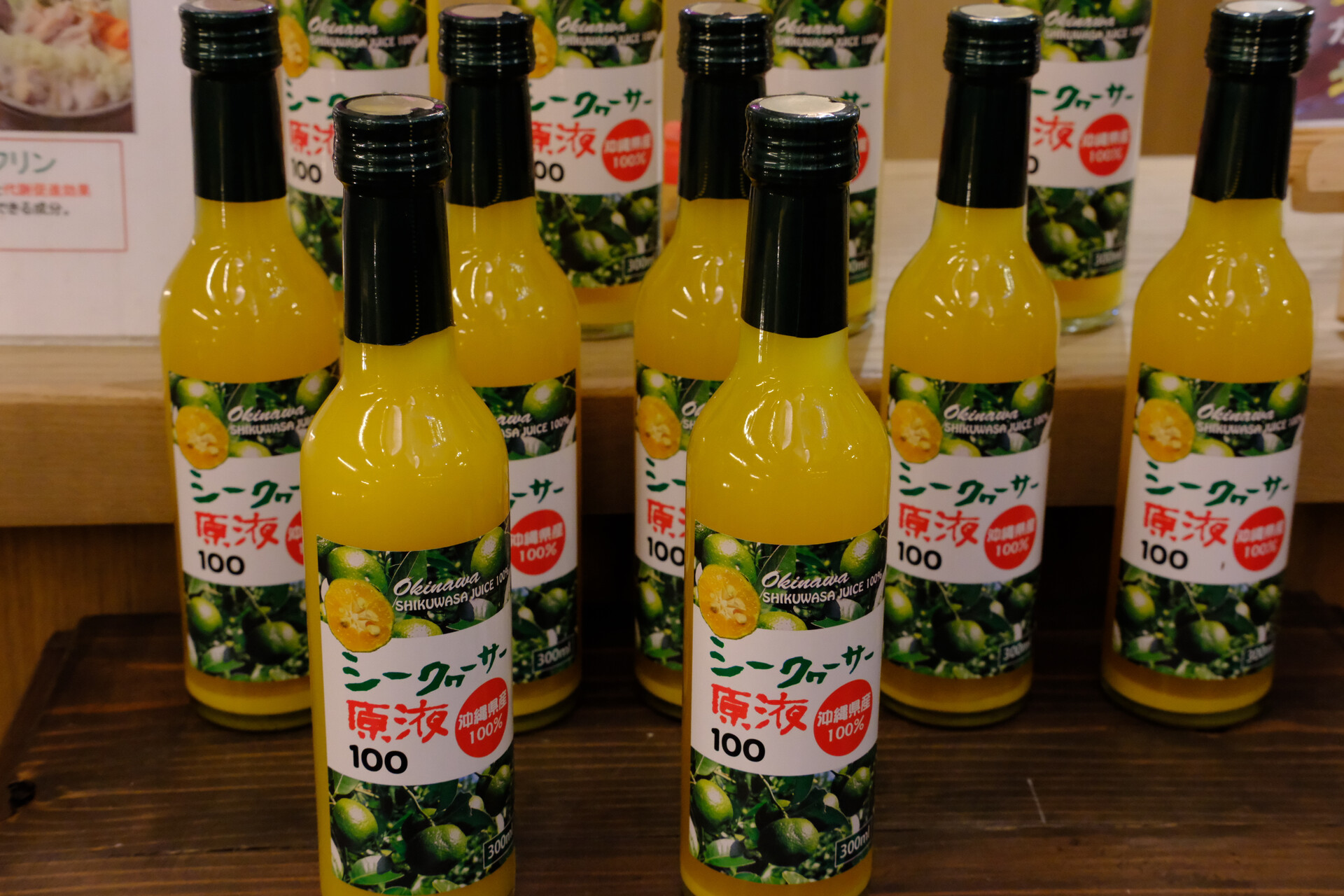
Shikuwasa juice is a popular beverage also known as Hirami lemon. Shikuwasa is a small, green citrus fruit native to Okinawa. The juice is tart and refreshing in flavour, like a cross between a lime and a mandarin orange.
Shikuwasa juice is not only appreciated for its unique taste but also for its health benefits. It’s rich in vitamin C and other nutrients, and is believed to aid in digestion and boost immunity. In Okinawa, shikuwasa juice is a staple in many households, used as a condiment, in cooking, and as a health drink. You can find it at the Nago Pineapple Park.
Pineapple Wine
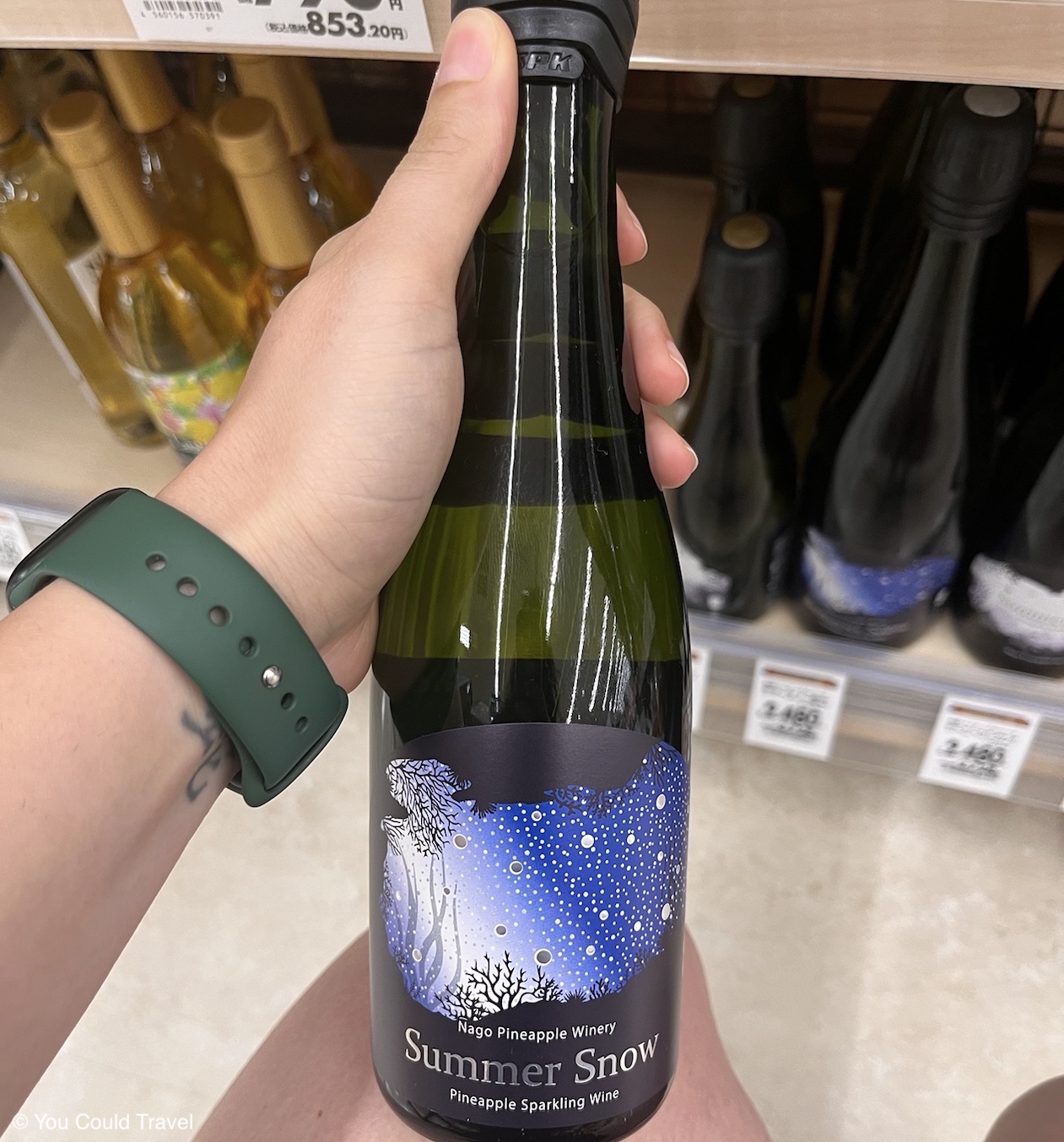
Pineapple wine is a unique alcoholic beverage made from pineapples. While not as widely known as grape wines, it’s a speciality in regions where pineapples are grown abundantly, including Okinawa. In Okinawa, the tropical climate is ideal for pineapple cultivation, leading to the production of this distinctive wine. You can sample some at the Nago Pineapple Park, and purchase it as a souvenir from there or from any Okinawan major supermarket.
Pineapple wine is lighter and sweeter than traditional grape wines, with a fruity and refreshing taste that captures the essence of pineapples. It has a lower alcohol content compared to grape wines, making it a popular choice for a light, tropical drink.
Orion Beer
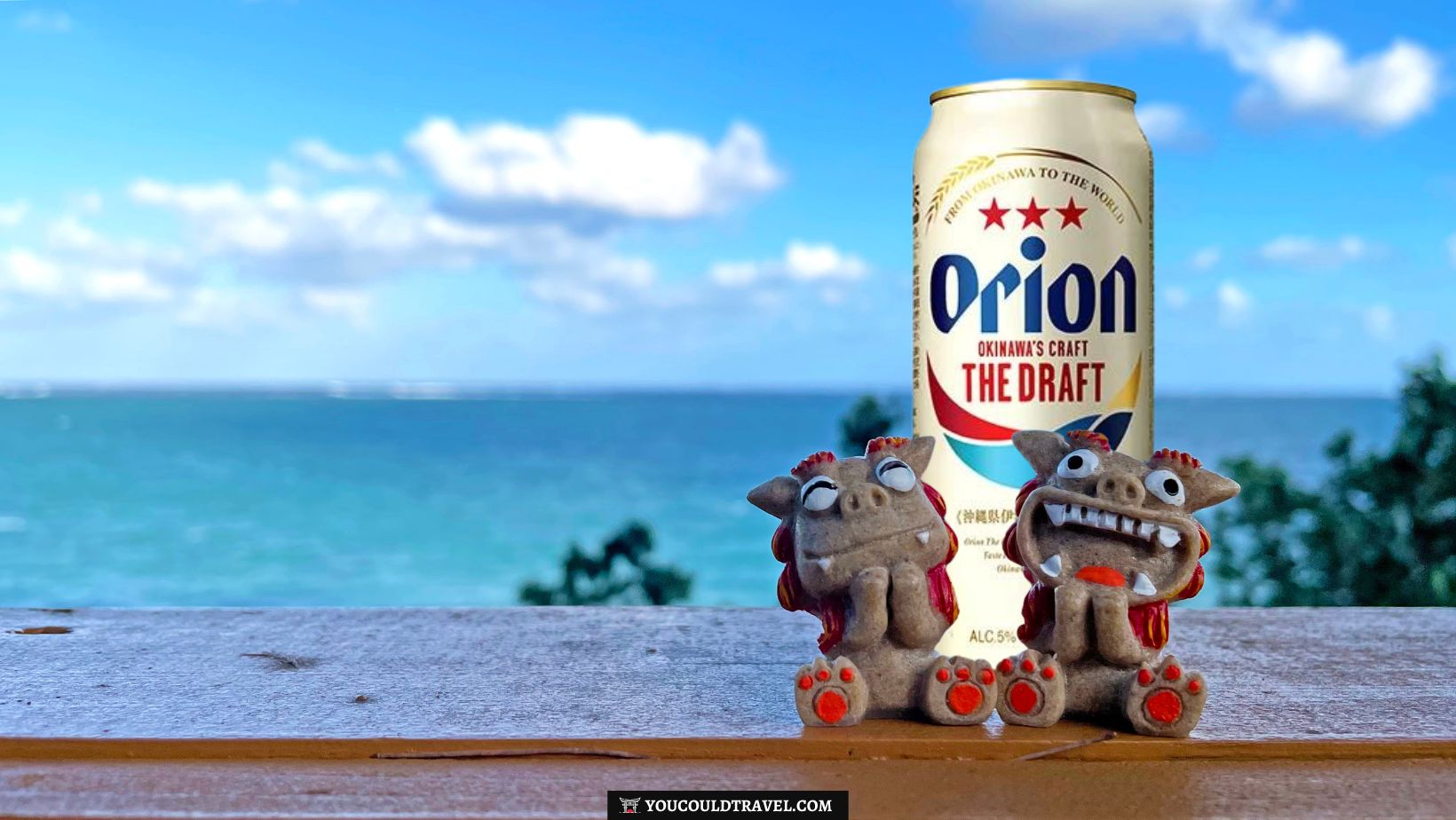
Orion Beer is one of the most popular and iconic beer brands from Okinawa. It has a significant presence in the Japanese beer market, and as you can imagine, it is associated with the tropical and laid-back atmosphere of Okinawa.
The taste of Orion Beer is light and crisp, making it especially refreshing in hot weather. It’s praised for its smoothness and easy drinkability, with a relatively mild flavour profile that appeals to a broad range of beer drinkers. You can find it everywhere in Okinawan, in virtually every restaurant, shop and izakaya.
Awamori
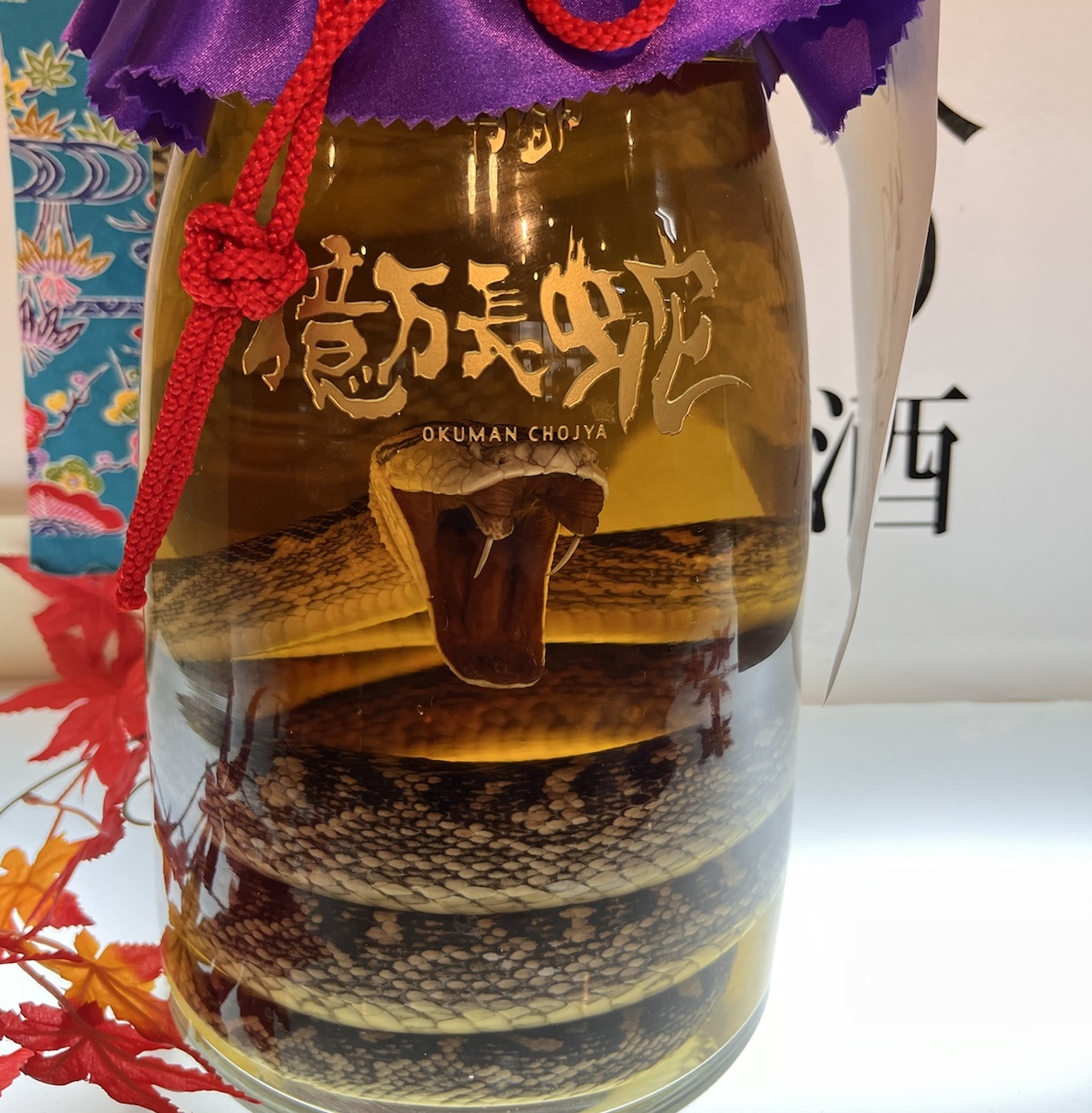
Awamori is a traditional alcoholic beverage from Okinawa, distinct from sake, which is more commonly known throughout the rest of the country. Made from long-grain indica rice, awamori is unique in that the rice is first fermented with black koji mould, which originates from Thailand. This fermentation process is what sets awamori apart from other Japanese rice-based spirits.
The drink has a strong flavour and a high alcohol content, ranging from 30% to 40% alcohol by volume. Awamori can be enjoyed in various ways: straight, on the rocks, diluted with water, or as part of a cocktail.
A somewhat controversial type of awamori is the Habushu. Habushu is made by infusing awamori with a pit viper snake. The snake is submerged whole in the awamori, and the drink is left to steep for an extended period. This process is believed to impart medicinal properties to the liquor, a belief rooted in traditional Asian medicine.
The snake used in Habushu is usually a habu viper, a venomous snake native to the Okinawan region. The alcohol neutralizes the venom, making it safe to drink.

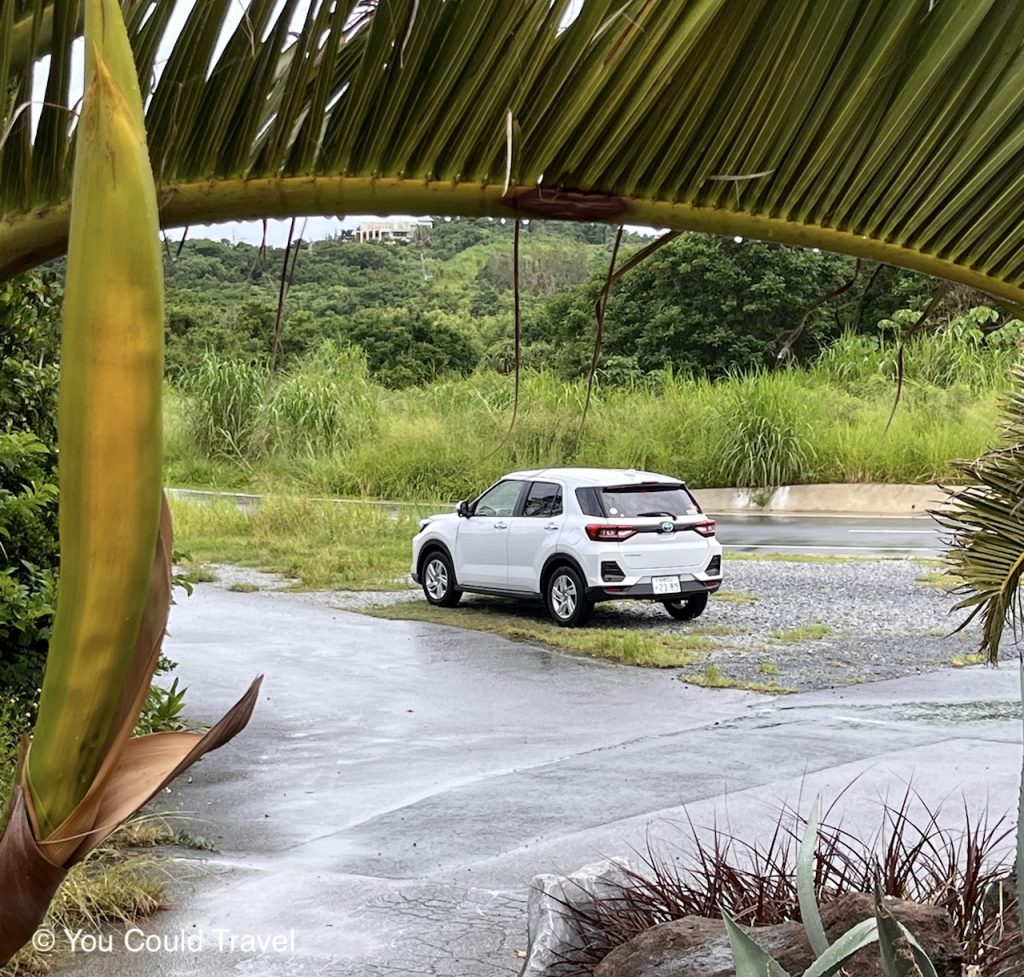

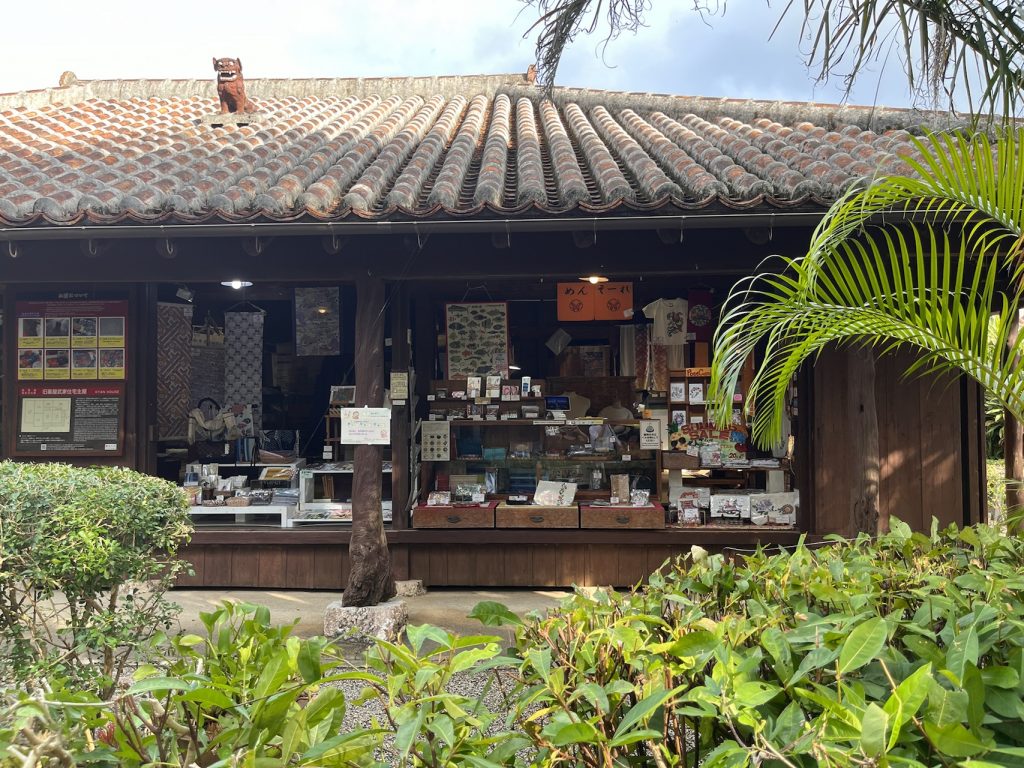
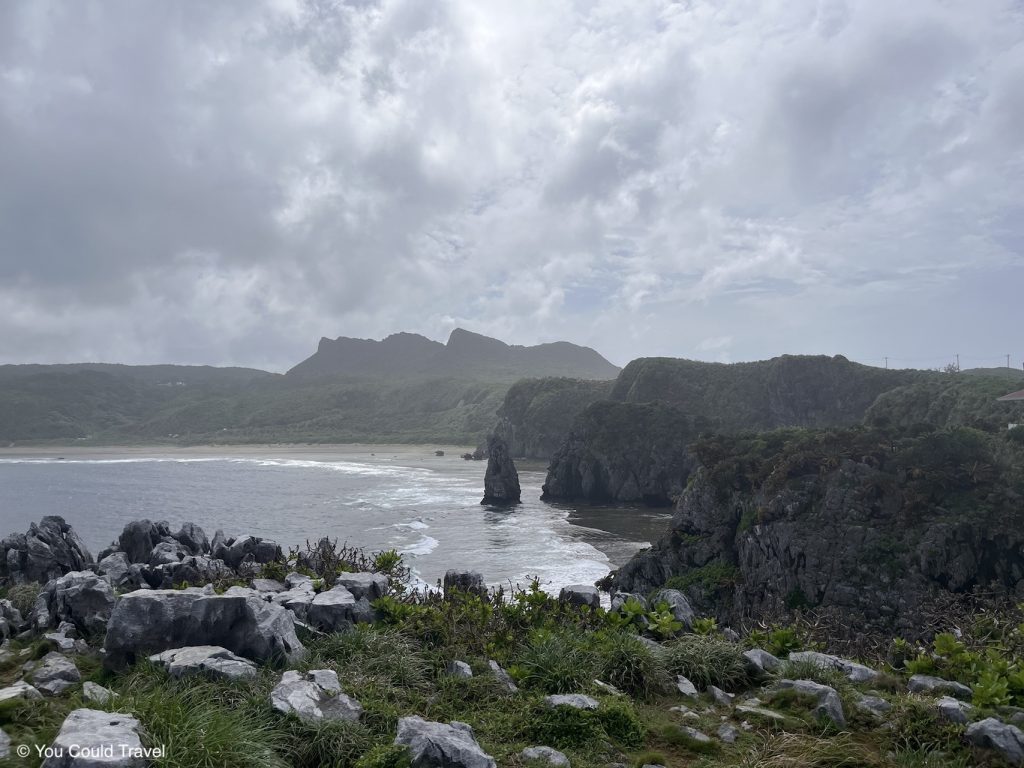
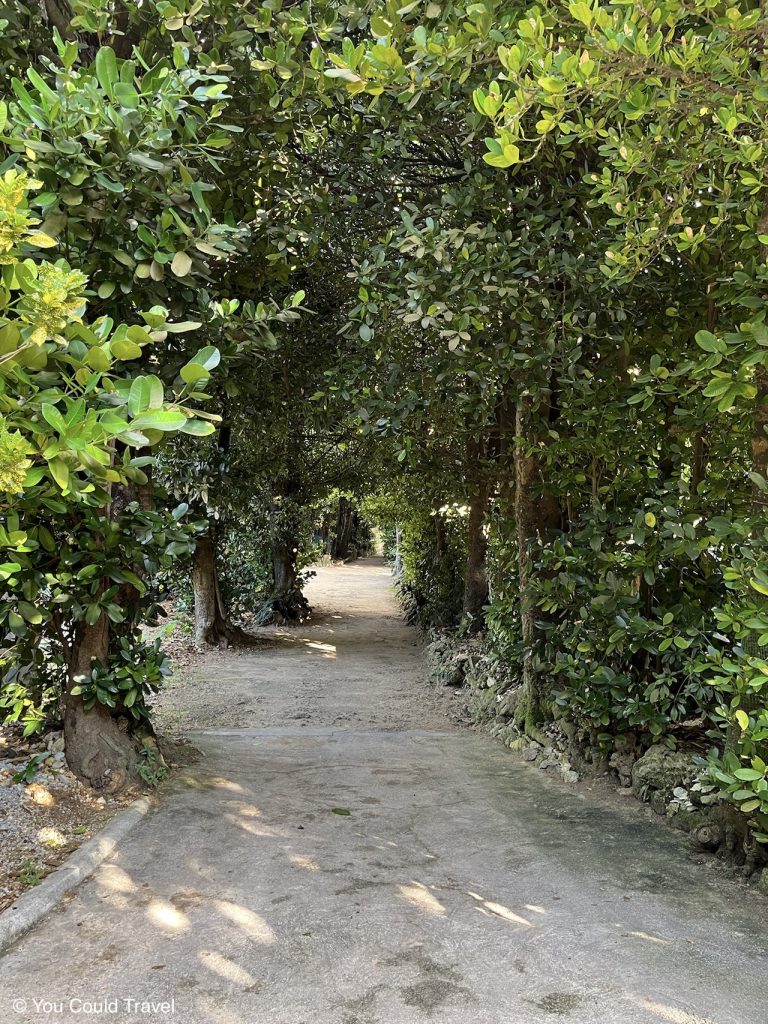



Leave a Reply